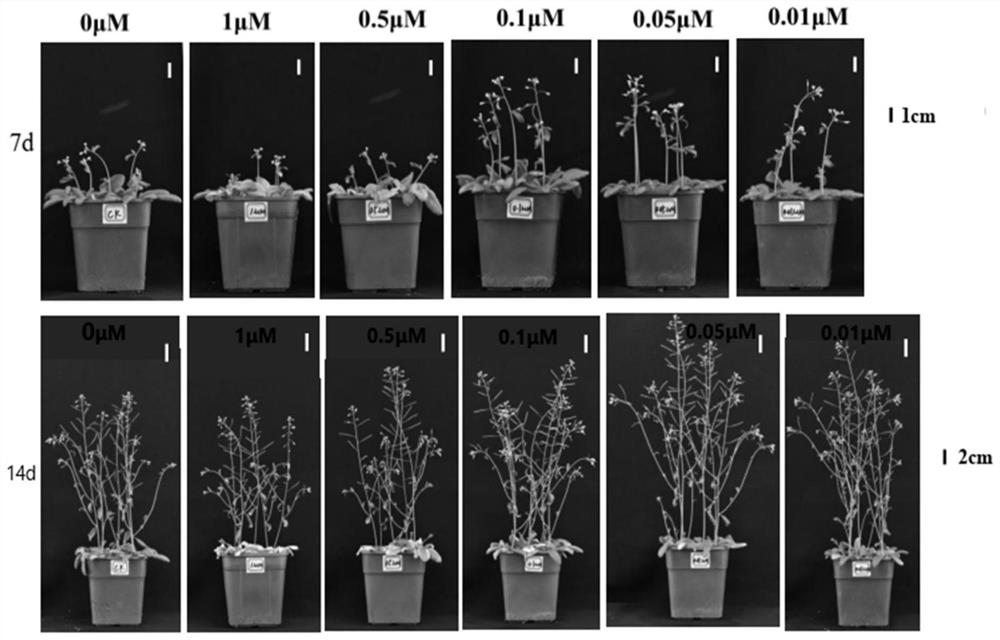Application of fluridone as strigolactone inhibitor
A strigolactone and inhibitor technology, applied in the field of pesticides, can solve the problems of high price and no growth regulator of strigolactone inhibitors, achieve low price, improve the ability to resist adversity, and save labor consumption Effect
- Summary
- Abstract
- Description
- Claims
- Application Information
AI Technical Summary
Problems solved by technology
Method used
Image
Examples
Embodiment 1
[0023] The influence of embodiment 1 fluridone solution spray concentration on Arabidopsis branch
[0024] The experiment was repeated three times, and the method of repeating the experiment each time was as follows:
[0025] (1) Material preparation. Arabidopsis was used as a model plant.
[0026] (2) Seed selection and disinfection. The Arabidopsis seeds were sequentially carried out according to the following steps: select Columbia wild-type Arabidopsis seeds, soak and disinfect the seeds with 75% ethanol for 15 minutes; wash with sterilized deionized water for 5 times to obtain Arabidopsis sterilized seeds.
[0027] (3) Seedling growth. The Arabidopsis seeds obtained in step (2) were spot-planted on 1 / 2 MS solid medium, put into a refrigerator at 4°C for vernalization for 3 days, and then placed at 22°C and cultured for 7 days under 16 hours of light and 8 hours of darkness. When Arabidopsis thaliana grows 4 leaves, it is transplanted into small pots (size: 10cm×10cm) ...
Embodiment 2
[0034] The influence of embodiment 2 fluridone spray concentration on Arabidopsis branch
[0035] The experimental steps of the effect of fluridone spraying concentration on Arabidopsis branches are as follows:
[0036] (1) Material preparation. Arabidopsis was used as a model plant.
[0037] (2) Seed selection and disinfection. The Arabidopsis seeds were followed by the following steps: select Columbia wild-type Arabidopsis seeds, use 75% ethanol to soak and disinfect the seeds for 15 minutes; wash 3-5 times with sterilized deionized water to obtain Arabidopsis sterilized seed.
[0038] (3) Seedling growth. The Arabidopsis seeds obtained in step (2) were spot-planted on 1 / 2 MS solid medium, put into a refrigerator at 4°C for vernalization for 3 days, and then placed at 22°C and cultured for 7 days under 16 hours of light and 8 hours of darkness. When four leaves of A. thaliana grow, they are transplanted into small pots (size: 10cm×10cm) for cultivation, and 5 plants are...
Embodiment 3
[0044] The influence of embodiment 3 fluridone spray concentration on the growth of Arabidopsis
[0045] The Arabidopsis plants sprayed with different concentrations of fluridone reagent ((0.01, 0.05, 0.1, 0.5, 1 μM) and control group CK) in Example 1 were detected for one week, and their photosynthetic intensity under different concentrations were measured. and physiological indicators.
[0046]Photosynthetic intensity measurement: use the LI-COR / LI-6400 portable photosynthetic measurement system to measure and output photosynthetic intensity indicators.
[0047] The results of different concentrations of fluridone solution on the leaves of Arabidopsis are as follows: figure 2 As shown, it can be seen from the figure that the leaves of Arabidopsis thaliana in the fluridone solution with a concentration of 0.1-1 μM all have a certain degree of yellowing. The results of photosynthetic intensity were measured as image 3 As shown in the figure, it can be seen from the figure...
PUM
 Login to View More
Login to View More Abstract
Description
Claims
Application Information
 Login to View More
Login to View More - R&D
- Intellectual Property
- Life Sciences
- Materials
- Tech Scout
- Unparalleled Data Quality
- Higher Quality Content
- 60% Fewer Hallucinations
Browse by: Latest US Patents, China's latest patents, Technical Efficacy Thesaurus, Application Domain, Technology Topic, Popular Technical Reports.
© 2025 PatSnap. All rights reserved.Legal|Privacy policy|Modern Slavery Act Transparency Statement|Sitemap|About US| Contact US: help@patsnap.com



